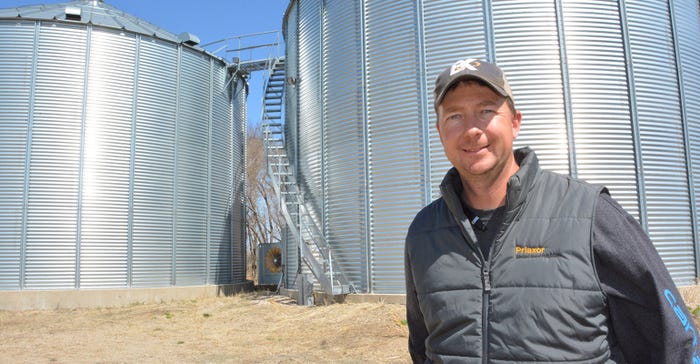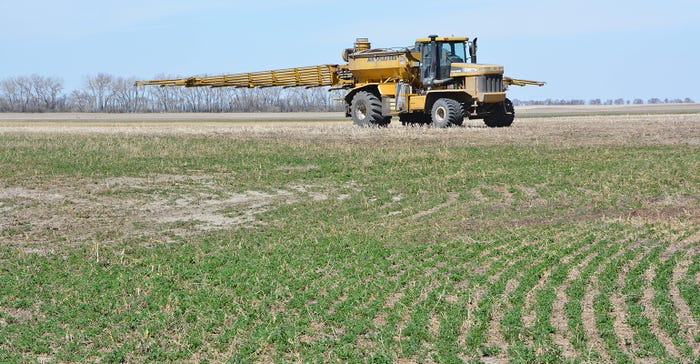December 7, 2018

Bryan Kenner, Maddock, N.D., figures there are three core drivers of wheat yields, and that's where he invests most of his money and attention.
According to Kenner, the three core profit drivers for wheat are:
1. Genetics. There are new varieties on the market with more yield potential, disease resistance and straw strength than older varieties. Among Kenner's current favorites for his central North Dakota farm are Westbred WB9479 and WB9590; University of Minnesota Shelly; 21st Century Genetics TCG-Climax; and Limagrain Cereals LCS Rebel.
The Westbred varieties are high yielding with above-average protein, he says. Climax has high yield and high protein potential. Shelly has high yield and average protein profile. Rebel is a high-yielding variety with dependable protein content.
Besides growing commercial wheat, Kenner also grows wheat seed and operates BK Seeds, an ag retail outlet.
 WHEAT KEYS: Bryan Kenner looks for consistent, proven returns on inputs. As a result, he focuses on three major core inputs: genetics, fertilizer and plant health.
WHEAT KEYS: Bryan Kenner looks for consistent, proven returns on inputs. As a result, he focuses on three major core inputs: genetics, fertilizer and plant health.

It takes the right seeding rate to get the most from the new varieties, Kenner says. Wheat varieties that tiller aggressively don't have to be seeded as thick as other varieties. This year, he seeded wheat at rates ranging from 1.3 to 1.8 million seeds per acre.
2. Fertilizer. Kenner's yield goals range from 60-85 bushels per acre, depending on the variety and the soil type. He varies fertilizer rates according to management zones. The prescription is based on soil types, soil test results, nitrogen credits and other factors.
On average, Kenner applies 300 pounds of 46-0-0 in the spring and incorporates the urea and prepares the seedbed at the same time with a vertical tillage tool. He co-owns a TerraGator Floater with a neighbor and spreads the urea himself.
Kenner has about 300 tons of urea storage, so he can buy and take delivery of fertilizer when he can save the most money. He also variable rate applies 40-100 pounds per acre of a phosphorus fertilizer with the seed at planting.
 BEST SEED: Curtis Kenner, Bryan Kenner’s father, fills an air seeder with wheat seed. Wheat genetics have improved in recent year, increasing yield and other factors that affect profitability.
BEST SEED: Curtis Kenner, Bryan Kenner’s father, fills an air seeder with wheat seed. Wheat genetics have improved in recent year, increasing yield and other factors that affect profitability.

"It's a pretty fast, efficient way to get on fertilizer on," Kenner says. "We can cover a lot of ground quickly."
3. Weed control and plant health. Fields have to be weed-free and wheat plants have to be disease-free to maximize yield potential. Kenner works with a crop consultant who makes field-by-field herbicide recommendations based the weed spectrum. "We try to mix up our modes of action to help fight resistance," Kenner says.
To keep plants healthy, Kenner applies fungicide twice during the growing season, once when the wheat is in the 4-5 leaf stage and again at flowering. The first application protects the plants from rust and other leaf diseases. The second is to prevent scab from infecting the wheat heads. Kenner watches the crop and monitors the weather forecast closely to stay ahead of disease outbreaks. "Unless we have a very poor crop due to drought or something else, we will apply the fungicide," he says. "It is going on nine out of 10 years."
Proven return
As an ag retailer, Kenner has his pick of new crop protection products. "We try a lot of different things because I don't want to sell anything that we wouldn't use ourselves," he says.
 COVER CROP: A salt-tolerant alfalfa grows on the on the edge of one of Bryan Kenner’s fields field. He uses the alfalfa to help manage saline areas.
COVER CROP: A salt-tolerant alfalfa grows on the on the edge of one of Bryan Kenner’s fields field. He uses the alfalfa to help manage saline areas.

Kenner looks for consistent, proven returns from the new products. They have a high bar to meet before he uses them routinely.
"If we have $5 per acre to spend, I want to put into something that I know is going to give us a return," Kenner says. "Usually, that is one of the core [practices] that drive wheat profitability."
You May Also Like




